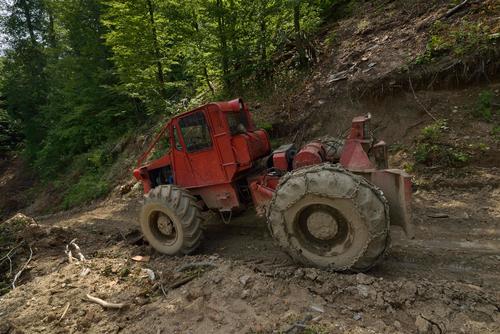EuroNatur and Agent Green: Europe must halt forest destruction in Romania

"Indian Summer" in Romania's Paradise Forests
© Matthias Schickhofer/EuroNatur
With heavy machines the trees are pulled out of the virgin forests (like here in Domogled). What remains are degraded areas.
© Matthias SchickhoferBucharest / Radolfzell: While Europe is shocked about the forest destruction in the Amazon, central Europe’s largest natural forests in Romania are vanishing due to logging. EuroNatur Foundation submitted a comprehensive inventory of the valuable forest stocks of Romania: PRIMOFARO (PRIMary and Old growth Forest Areas of Romania)
The results are promising - and concerning: Romania still host more than 525.000 hectares of old growth and virgin forests, more than any other EU member state (outside Scandinavia). But the analysis also reveals that forest destruction moves ahead quickly.
At least on paper, two thirds - more than 330.000 hectares - of Romania’s natural and virgin forests are protected, because they are already part of the EU Natura 2000 network (which includes all national parks). But most of these forests lack any effective protection. Only 6 per cent of these forests have been listed with the Romanian „National Catalogue of Virgin Forests“so far. This programme grants protecttion only to those forests that comply with the strictest virgin forest criteria. Other natural forests are left without any protection. As a consequence, logging in Natura 2000 sites and national parks is omnipresent. PRIMOFARO also shows that almost 50 percent of Romania’s virgin forests, which were identified in 2005 as part of a comprehensive inventory of virgin forests, are degraded or destroyed already.
„We intentionally looked beyond the narrow scope of ‚virgin forests’ and tried to identify high biological and climate value forests in Romania. Around 8percent of Romania’s forests are still in a very natural status. They are somehow the European equivalent of the Amazon forest. Thus they all deserve special protection,“ PRIMOFARO co-author Matthias Schickhofer underlines.
„Europe needs to act together to preserve the outstanding natural heritage of Romania. We expect that Romania respects international law and fully comply with Natura 2000 legislation: Natura 2000 protected natural forests on state property have to be protected by the governmental action immediately. Financial compensation, which must also be supported by the EU, is indispensable for private natural and virgin forest areas,“ Gabriel Schwaderer, Executive Director of EuroNatur Foundation says.
While the Romanian government kept conservationists busy with a bureaucratic burdens in conjunction with the ‚Virgin Forests Catalogue‘, 10.000s of hectares of natural forests in Natura 2000 sites and national parks were destroyed. EU legislation obliges us to protect all forests in good conservation status, not just a few virgin forest museums,“ Gabriel Paun, president of Agent Green explains.
EuroNatur Foundation and Agent Green call on the European Union and on Romania to take urgent action to save this „European equivalent of the Amazon natural forest“ and to ensure that Natura 2000 legislation is enforced in Romania. It was only on 10 September 2019 that EuroNatur, Agent Green and Client Earth submitted an EU complaint about systematic violations of EU forestry legislation by the Romanian state.
Background information:
Link to the study: www.euronatur.org/fileadmin/docs/Urwald-Kampagne_Rumaenien/PRIMOFARO_24092019_layouted.pdf
The results of the PRIMOFARO inventory:
- The analysis constitutes the biggest cluster of close-to-nature (old-growth and primary) forest in an EU country outside Scandinavia: 525,632 hectares of untouched or semi-natural forests, home to many strictly protected species.
- 332,844 hectares (63%) are located within Natura 2000 sites, 81,716 hectares of which are additionally protected as national parks. Even in these protected areas, natural forests are not safe from deforestation.
- However, only 116,589 hectares (or 55 percent) of the 2005 so called Pin Matra inventory still appear to be in an intact status.
Methodology of PRIMOFARO:
The PRIMOFARO digital map is based upon detailed visual analyses of satellite images, applying science based criteria to distinguish between natural forest stands and production forest. The analyses was calibrated by use of images of example areas and during several field visits (over the course of more than 2 years) and by data provision from partnering primary forest research projects (REMOTE project led by University of Prague and a forest mapping project led by Forsthochschule Rottenburg, financed by Deutsche Bundesstiftung Umwelt).
The findings were validated during several field trips and by an evaluation of PRIMOFARO digital maps against historical CORONA satellite images. CORONA are espionage images created by the US Army in the 1960ties. Only 2% of the initial data sets showed signs of logging in the 1960ties (roads logging areas). These polygons were excluded from the PRIMOFARO digital map.
Forest protection in Romania:
So far, the Romanian forest protection program („Virgin Forest Catalogue“) almost exclusively is focused at protection of „virgin forests“, which are defined by rather strict identification criteria, laid down in Ministerial Orders. These criteria have been applied in a very restrictive way and the registration process is scandalously slow., This leds to exclusion of numerous natural and virgin and even many virgin forests of international importance are still unprotected and acutely threatened by logging.. As a result, a large number of primary forests with international significance are not protected and are under threat of logging.
In addition, the EU Nature Directives do not restrict conservation obligations to „virgin“ forests only. The Habitats and the Birds Directives bind EU member states of ensure avoidance of deterioration and degradation of habitats in good conservation status. Romania widely fails or implements this EU legislation.
Primary forests and old growth forests:
The PRIMOFARO inventory identifies “primary forests” (according to the Romanian definition), but also „old growth forests“ which were probably influenced by humans in a very extensive way or long time ago. Both, old growth and primary forests harbor rich biodiversity (like: hermit beetles, alpine longhorn beetles, bats, woodpeckers, owls, capercaillies, bears, lynxes, etc.) and capture large amounts of carbon.
Contact:
Anja Arning, anja.arning(at)euronatur.org, Tel.: +49 (0)7732 - 92 72 13


